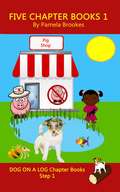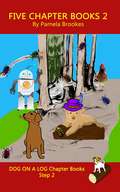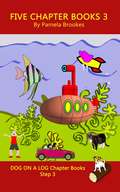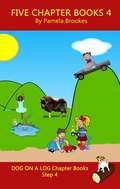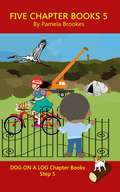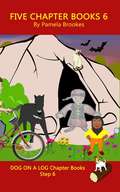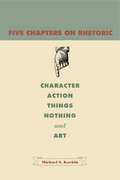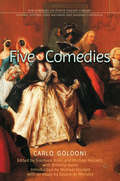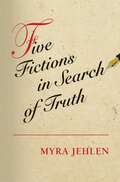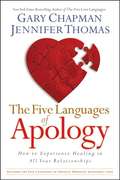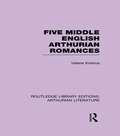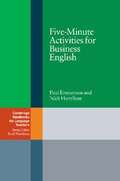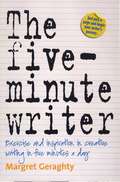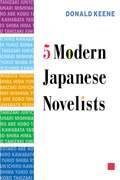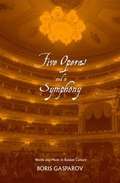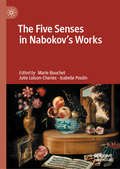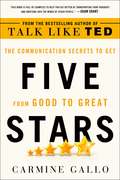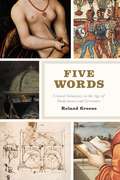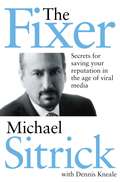- Table View
- List View
Five Chapter Books 1: Decodable Books for Phonics Readers and Dyslexia/Dyslexic Learners (DOG ON A LOG Chapter Book Collection #Volume 1)
by Pamela BrookesDecodable Chapter Books for Phonics Readers and folks with a Dyslexic Learning Style <P><P>This collection is the five books in Step 1 of the DOG ON A LOG Chapter book series. <P><P>The books are: The Dog On The Log</br> The Pig Hat</br> Chad The Cat</br> Zip The Bug</br> The Fish and The Pig <P><P>Individual books can also be purchased separately. <P><P>Sight Words:</br> a, are, be, does, go, goes, has, he, her, his, into, is, like, my, of, OK, says, see, she, the, they, to, want, you <P><P>Each book has about 260 to 470 total words <P><P>These are Step 1 Chapter books. <P><P>The DOG ON A LOG Books series are for phonics readers and folks with a dyslexic learning style. The words used reflect the inclusion of 1 to 3 new phonics rules in each step. There are five books at each step. <P><P>The chapter books are written in a chapter format with one picture in most chapters. They are longer, have more detail, and sometimes offer more complexity than the Let’s GO! Books. They’re great for practicing known and new phonics rules. They’re also just fun reading. <P><P>DOG ON A LOG Let’s GO! Books are shorter versions of DOG ON A LOG Chapter books. Let’s GO! books tell the same stories with about 8 pictures and only a few sentences per page. They’re perfect as an introduction to the new phonics rules or simply for fun reading for younger kids. <P><P>DOG ON A LOG Phonics Progression <P><P>Step 1: Consonants, primary sounds Short vowels Digraphs: ch, sh, th, wh, ck 2 and 3 sound words Possessive ‘s <P><P>Step 2: Bonus letters (f, l, s, z after short vowel) “all” –s suffix <P><P>Step 3: ang, ing, ong, ung, ank, ink, onk, unk <P><P>Step 4: Consonant Blends to make 4 sound words 3 and 4 sound words ending in –lk, -sk <P><P>Step 5: Digraph blends –nch to make 3 and 4 sound words Silent e, including "-ke" <P><P>Step 6: ild, old, olt, ind, ost <P><P>Step 7: 5 sounds in a closed syllable word plus suffix -s (crunch, slumps) 3 letter blends and up to 6 sounds in a closed syllable word (script, spring) <P><P>Step 8: Two syllable words with 2 closed syllables, not blends (sunset, chicken, unfit) <P><P>WATCH FOR MORE STEPS AND BOOKS COMING SOON <P><P>For information on upcoming books see dogonalogbooks.com or visit our Facebook page.
Five Chapter Books 2: Decodable Books for Phonics Readers and Dyslexia/Dyslexic Learners (DOG ON A LOG Chapter Book Collections #Volume 2)
by Pamela BrookesDecodable Chapter Books for Phonics Readers and folks with a Dyslexic Learning Style. <P><P>This collection is the five books in Step 2 of the DOG ON A LOG Chapter book series. <P><P>The books are: <P><P>Mud On The Path</br> The Red Hen</br> The Hat And Bug Shop</br> Babs The ‘Bot</br> The Cub <P><P>Individual books can also be purchased separately. <P><P>Sight Words: </br> a, are, be, could, do, does, eggs, for, from, go, goes, has, have, he, her, here, his, I, into, is, like, likes, me, my, nest, of, OK, onto, or, puts, said, say, says, see, sees, she, should, the, they, to, want, wants, was, we, what, when, would, you, your <P><P>Each book has about 550 to 1,000 total words <P><P>These are Step 2 Chapter books. <P><P>The DOG ON A LOG Books series are for phonics readers and folks with a dyslexic learning style. The words used reflect the inclusion of 1 to 3 new phonics rules in each step. There are five books at each step. <P><P>The chapter books are written in a chapter format with one picture in most chapters. They are longer, have more detail, and sometimes offer more complexity than the Let’s GO! Books. They’re great for practicing known and new phonics rules. They’re also just fun reading. <P><P>DOG ON A LOG Let’s GO! Books are shorter versions of DOG ON A LOG Chapter books. Let’s GO! books tell the same stories with about 8 pictures and only a few sentences per page. They’re perfect as an introduction to the new phonics rules or simply for fun reading for younger kids. <P><P>DOG ON A LOG Phonics Progression <P><P>Step 1: Consonants, primary sounds Short vowels Digraphs: ch, sh, th, wh, ck 2 and 3 sound words Possessive ‘s <P><P>Step 2: Bonus letters (f, l, s, z after short vowel) “all” –s suffix <P><P>Step 3: ang, ing, ong, ung, ank, ink, onk, unk <P><P>Step 4: Consonant Blends to make 4 sound words 3 and 4 sound words ending in –lk, -sk <P><P>Step 5: Digraph blends –nch to make 3 and 4 sound words Silent e, including "-ke" <P><P>Step 6: ild, old, olt, ind, ost <P><P>Step 7: 5 sounds in a closed syllable word plus suffix -s (crunch, slumps) 3 letter blends and up to 6 sounds in a closed syllable word (script, spring) <P><P>Step 8: Two syllable words with 2 closed syllables, not blends (sunset, chicken, unfit) <P><P>WATCH FOR MORE STEPS AND BOOKS COMING SOON <P><P>For information on upcoming books see dogonalogbooks.com or visit our Facebook page.
Five Chapter Books 3: Decodable Books for Phonics Readers and Dyslexia/Dyslexic Learners (DOG ON A LOG Book Collections #Volume 3)
by Pamela BrookesDecodable Chapter Books for Phonics Readers and folks with a Dyslexic Learning Style <P><P>This collection is the five books in Step 3 of the DOG ON A LOG Chapter book series. <P><P>The books are: <P><P>Mr. Bing Has Hen Dots</br> The Junk Lot Cat</br> Bonk Punk Hot Rod</br> The Ship With Wings</br> The Sub In The Fish Tank <P><P>Individual books can also be purchased separately. <P><P>Sight Words: </br> a, are, as, be, could, do, does, for, from, go, goes, has, have, he, her, here, his, I, into, is, like, likes, me, Mr., Mrs., my, no, of, OK, or, put, puts, said, say, says, see, sees, she, should, the, their, there, they, to, want, wants, was, we, what, where, would, you, your <P><P>Each book has about 960 to 1,170 total words <P><P>These are Step 3 Chapter books. <P><P>The DOG ON A LOG Books series are for phonics readers and folks with a dyslexic learning style. The words used reflect the inclusion of 1 to 3 new phonics rules in each step. There are five books at each step. <P><P>The chapter books are written in a chapter format with one picture in most chapters. They are longer, have more detail, and sometimes offer more complexity than the Let’s GO! Books. They’re great for practicing known and new phonics rules. They’re also just fun reading. <P><P>DOG ON A LOG Let’s GO! Books are shorter versions of DOG ON A LOG Chapter books. Let’s GO! books tell the same stories with about 8 pictures and only a few sentences per page. They’re perfect as an introduction to the new phonics rules or simply for fun reading for younger kids. <P><P>DOG ON A LOG Phonics Progression <P><P>Step 1: Consonants, primary sounds Short vowels Digraphs: ch, sh, th, wh, ck 2 and 3 sound words Possessive ‘s <P><P>Step 2: Bonus letters (f, l, s, z after short vowel) “all” –s suffix <P><P>Step 3: ang, ing, ong, ung, ank, ink, onk, unk <P><P>Step 4: Consonant Blends to make 4 sound words 3 and 4 sound words ending in –lk, -sk <P><P>Step 5: Digraph blends –nch to make 3 and 4 sound words Silent e, including "-ke" <P><P>Step 6: ild, old, olt, ind, ost <P><P>Step 7: 5 sounds in a closed syllable word plus suffix -s (crunch, slumps) 3 letter blends and up to 6 sounds in a closed syllable word (script, spring) <P><P>Step 8: Two syllable words with 2 closed syllables, not blends (sunset, chicken, unfit) <P><P>WATCH FOR MORE STEPS AND BOOKS COMING SOON <P><P>For information on upcoming books see dogonalogbooks.com or visit our Facebook page.
Five Chapter Books 4: Decodable Books for Phonics Readers and Dyslexia/Dyslexic Learners (DOG ON A LOG Book Collections #Volume 4)
by Pamela Brookes<P><P>Decodable Chapter Books for Phonics Readers and folks with a Dyslexic Learning Style. <P><P>This collection is the five books in Step 4 of the DOG ON A LOG Chapter book series. <P><P>The books are: <P><P>The Push Truck</br> The Sand Hill</br> Lil Tilt And Mr. Ling</br> Musk Ox In The Tub</br> Trip To The Pond <P><P>Individual books can also be purchased separately. <P><P>Sight Words: </br> a, are, as, be, could, do, does, for, from, go, goes, has, have, he, her, here, his, I, into, is, like, likes, me, Mr., my, of, OK, or, push puts, said, saw. say, says, see, sees, she, should, the, there, they, to, want, wants, was, we, what, where, would, you, your <P><P>Each book has about 700 to 1,130 total words <P><P>These are Step 4 Chapter books. <P><P>The DOG ON A LOG Books series are for phonics readers and folks with a dyslexic learning style. The words used reflect the inclusion of 1 to 3 new phonics rules in each step. There are five books at each step. <P><P>The chapter books are written in a chapter format with one picture in most chapters. They are longer, have more detail, and sometimes offer more complexity than the Let’s GO! Books. They’re great for practicing known and new phonics rules. They’re also just fun reading. <P><P>DOG ON A LOG Let’s GO! Books are shorter versions of DOG ON A LOG Chapter books. Let’s GO! books tell the same stories with about 8 pictures and only a few sentences per page. They’re perfect as an introduction to the new phonics rules or simply for fun reading for younger kids. <P><P>DOG ON A LOG Phonics Progression <P><P>Step 1: Consonants, primary sounds Short vowels Digraphs: ch, sh, th, wh, ck 2 and 3 sound words Possessive ‘s <P><P>Step 2: Bonus letters (f, l, s, z after short vowel) “all” –s suffix <P><P>Step 3: ang, ing, ong, ung, ank, ink, onk, unk <P><P>Step 4: Consonant Blends to make 4 sound words 3 and 4 sound words ending in –lk, -sk <P><P>Step 5: Digraph blends –nch to make 3 and 4 sound words Silent e, including "-ke" <P><P>Step 6: ild, old, olt, ind, ost <P><P>Step 7: 5 sounds in a closed syllable word plus suffix -s (crunch, slumps) 3 letter blends and up to 6 sounds in a closed syllable word (script, spring) <P><P>Step 8: Two syllable words with 2 closed syllables, not blends (sunset, chicken, unfit) <P><P>WATCH FOR MORE STEPS AND BOOKS COMING SOON <P><P>For information on upcoming books see dogonalogbooks.com or visit our Facebook page.
Five Chapter Books 5: Decodable Books for Phonics Readers and Dyslexia/Dyslexic Learners (DOG ON A LOG Chapter Book Collections #Volume 5)
by Pamela BrookesDecodable Chapter Books for Phonics Readers and folks with a Dyslexic Learning Style. <P><P>This collection is the five books in Step 5 of the DOG ON A LOG Chapter book series. <P><P>The books are: <P><P>Bake A Cake</br> The Crane At The Cave</br> Ride A Bike</br> Crane Or Crane?</br> The Swing Gate <P><P>Individual books can also be purchased separately. <P><P>Sight Words: </br> a, are, as, be, come, comes, could, do, does, egg, eggs, for, from, go, goes, has, have, he, her, here, his, I, into, is, me, my, of, OK, or, pull, pulls, put, puts, said, say, says, see, sees, she, should, talk, the, their, there, they, to, walk, walks, want, wants, was, we, what, where, would, you, your <P><P>Each book has about 1,000 to 1,190 total words <P><P>These are Step 5 Chapter books. <P><P>The DOG ON A LOG Books series are for phonics readers and folks with a dyslexic learning style. The words used reflect the inclusion of 1 to 3 new phonics rules in each step. There are five books at each step. <P><P>The chapter books are written in a chapter format with one picture in most chapters. They are longer, have more detail, and sometimes offer more complexity than the Let’s GO! Books. They’re great for practicing known and new phonics rules. They’re also just fun reading. <P><P>DOG ON A LOG Let’s GO! Books are shorter versions of DOG ON A LOG Chapter books. Let’s GO! books tell the same stories with about 8 pictures and only a few sentences per page. They’re perfect as an introduction to the new phonics rules or simply for fun reading for younger kids. <P><P>DOG ON A LOG Phonics Progression <P><P>Step 1: Consonants, primary sounds Short vowels Digraphs: ch, sh, th, wh, ck 2 and 3 sound words Possessive ‘s <P><P>Step 2: Bonus letters (f, l, s, z after short vowel) “all” –s suffix <P><P>Step 3: ang, ing, ong, ung, ank, ink, onk, unk <P><P>Step 4: Consonant Blends to make 4 sound words 3 and 4 sound words ending in –lk, -sk <P><P>Step 5: Digraph blends –nch to make 3 and 4 sound words Silent e, including "-ke" <P><P>Step 6: ild, old, olt, ind, ost <P><P>Step 7: 5 sounds in a closed syllable word plus suffix -s (crunch, slumps) 3 letter blends and up to 6 sounds in a closed syllable word (script, spring) <P><P>Step 8: Two syllable words with 2 closed syllables, not blends (sunset, chicken, unfit) <P><P>WATCH FOR MORE STEPS AND BOOKS COMING SOON <P><P>For information on upcoming books see dogonalogbooks.com or visit our Facebook page.
Five Chapter Books 6: Decodable Books for Phonics Readers and Dyslexia/Dyslexic Learners (DOG ON A LOG Chapter Books #Volume 6)
by Pamela BrookesDecodable Chapter Books for Phonics Readers and folks with a Dyslexic Learning Style. <P><P>This collection is the five books in Step 6 of the DOG ON A LOG Chapter book series. <P><P>The books are: <P><P>The Colt </br> The Gold Bolt </br> Hide In The Blinds </br> The Stone Child </br> Tolt The Kind Cat <P><P>Sight Words: </br> a, are, as, be, come, comes, could, do, does, for, from, go, goes, has, have, he, her, here, his, I, into, is, me, Ms., my, no, of, OK, onto, or, pull, pulls, push, put, puts, said, say, says, see, sees, she, should, so, some, talk, talks, the, their, there, they, to, walk, walks, want, wants, was, we, what, where, would, you, your, yours <P><P>Each book has about 1,390 to 2,000 total words <P><P>These are Step 6 Chapter books. <P><P>The DOG ON A LOG Books series are for phonics readers and folks with a dyslexic learning style. The words used reflect the inclusion of 1 to 3 new phonics rules in each step. There are five books at each step. <P><P>The chapter books are written in a chapter format with one picture in most chapters. They are longer, have more detail, and sometimes offer more complexity than the Let’s GO! Books. They’re great for practicing known and new phonics rules. They’re also just fun reading. <P><P>DOG ON A LOG Let’s GO! Books are shorter versions of DOG ON A LOG Chapter books. Let’s GO! books tell the same stories with about 8 pictures and only a few sentences per page. They’re perfect as an introduction to the new phonics rules or simply for fun reading for younger kids. <P><P>DOG ON A LOG Phonics Progression <P><P>Step 1: Consonants, primary sounds Short vowels Digraphs: ch, sh, th, wh, ck 2 and 3 sound words Possessive ‘s <P><P>Step 2: Bonus letters (f, l, s, z after short vowel) “all” –s suffix <P><P>Step 3: ang, ing, ong, ung, ank, ink, onk, unk <P><P>Step 4: Consonant Blends to make 4 sound words 3 and 4 sound words ending in –lk, -sk <P><P>Step 5: Digraph blends –nch to make 3 and 4 sound words Silent e, including "-ke" <P><P>Step 6: ild, old, olt, ind, ost <P><P>Step 7: 5 sounds in a closed syllable word plus suffix -s (crunch, slumps) 3 letter blends and up to 6 sounds in a closed syllable word (script, spring) <P><P>Step 8: Two syllable words with 2 closed syllables, not blends (sunset, chicken, unfit) <P><P>WATCH FOR MORE STEPS AND BOOKS COMING SOON <P><P>For information on upcoming books see dogonalogbooks.com or visit our Facebook page.
Five Chapters on Rhetoric: Character, Action, Things, Nothing, and Art (G - Reference, Information and Interdisciplinary Subjects)
by Michael S. KochinMichael Kochin’s radical exploration of rhetoric is built around five fundamental concepts that illuminate how rhetoric functions in the public sphere. To speak persuasively is to bring new things into existence—to create a political movement out of a crowd, or an army out of a mob. Five Chapters on Rhetoric explores our path to things through our judgments of character and action. It shows how speech and writing are used to defend the fabric of social life from things or facts. Finally, Kochin shows how the art of rhetoric aids us in clarifying things when we speak to communicate, and helps protect us from their terrible clarity when we speak to maintain our connections to others.Kochin weaves together rhetorical criticism, classical rhetoric, science studies, public relations, and political communication into a compelling overview both of persuasive strategies in contemporary politics and of the nature and scope of rhetorical studies.
Five Chapters on Rhetoric: Character, Action, Things, Nothing, and Art
by Michael S. KochinMichael Kochin’s radical exploration of rhetoric is built around five fundamental concepts that illuminate how rhetoric functions in the public sphere. To speak persuasively is to bring new things into existence—to create a political movement out of a crowd, or an army out of a mob. Five Chapters on Rhetoric explores our path to things through our judgments of character and action. It shows how speech and writing are used to defend the fabric of social life from things or facts. Finally, Kochin shows how the art of rhetoric aids us in clarifying things when we speak to communicate, and helps protect us from their terrible clarity when we speak to maintain our connections to others.Kochin weaves together rhetorical criticism, classical rhetoric, science studies, public relations, and political communication into a compelling overview both of persuasive strategies in contemporary politics and of the nature and scope of rhetorical studies.
Five Comedies
by Brittany Asaro Gianluca Rizzo Carlo Goldoni Michael Hackett Cesare De MichelisOne of the first and most important Italian playwrights to move away from the commedia dell'arte tradition of improvisation, Carlo Goldoni (1707-1793) wrote more naturalistic "comedies of character" that featured the dialect and situations of everyday life in Venice.Five Comedies collects a selection of Goldoni's finest plays, annotated and translated into English: The New House, The Coffee House, and "The Holiday Trilogy" (Off to the Country, Adventures in the Country, and Back from the Country). Editor Michael Hackett provides an introduction to Goldoni and his performance tradition for directors, actors, and designers, revealing the masterful construction of Goldoni's plays, while an afterword by Cesare de Michelis carefully reconstructs the playwright's life and times.
Five Fictions in Search of Truth
by Myra JehlenFiction, far from being the opposite of truth, is wholly bent on finding it out, and writing novels is a way to know the real world as objectively as possible. In Five Fictions in Search of Truth, Myra Jehlen develops this idea through readings of works by Flaubert, James, and Nabokov. She invokes Proust's famous search for lost memory as the exemplary literary process, which strives, whatever its materials, for a true knowledge. In Salammbô, Flaubert digs up Carthage; in The Ambassadors, James plumbs the examined life and touches at its limits; while in Lolita, Nabokov traces a search for truth that becomes a trespass. In these readings, form and style emerge as fiction's means for taking hold of reality, which is to say that they are as epistemological as they are aesthetic, each one emerging by way of the other. The aesthetic aspects of a literary work are just so many instruments for exploring a subject, and the beauty and pleasure of a work confirm the validity of its account of the world. For Flaubert, famously, a beautiful sentence was proven true by its beauty. James and Nabokov wrote on the same assumption--that form and style were at once the origin and the confirmation of a work's truth. In Five Fictions in Search of Truth, Jehlen shows, moreover, that fiction's findings are not only about the world but immanent within it. Literature works concretely, through this form, that style, this image, that word, seeking a truth that is equally concrete. Writers write--and readers read--to discover an incarnate, secular knowledge, and in doing so they enact a basic concurrence between literature and science.Some images inside the book are unavailable due to digital copyright restrictions.
Five for Freedom: A Study of Feminism in Fiction (Routledge Revivals)
by Geoffrey WagnerFirst published in 1972 Five for Freedom is a candid study of five European fictional heroines as anticipatory of contemporary feminism: Madame de Merteuil of Choderlos de Laclos’ Les Liaisons dangereuses, Jane Eyre, Emma Bovary, Tess of the D’Urbervilles, and Tony Buddenbrook. Professor Wagner clearly believes that, in the first place, the role of women in the development of fiction has been underestimated, while the claims to originality of many recent female liberationists have been equally overestimated. This is a far-ranging, lightly-handled book with insights into both mode of fiction, as it developed and answered women’s demands, and into the role of some of its leading heroines; for Professor Wagner’s studies do not limit themselves strictly to the ‘five for freedom’ but foray into Balzac’s Cousine Bette, Catherine Earnshaw of Wuthering Heights, Anna Karenina, and Eca de Queiroz’s Portuguese Bovary in Cousin Bazilio. This brilliant little study is topical, readable, yet learned. It will be useful for scholars and researchers of literature, Women’s studies, and Gender studies.
The Five Languages Of Apology
by Gary Chapman Jennifer ThomasREAL LIFE INVOLVES real people who make real mistakes. Sometimes saying I'm sorry"just isn't enough. The need for apologies impacts all human relationships. The good news is that you can learn the art of apology. Through their research and interaction with hundreds of individuals, counselor Dr. Jennifer Thomas and Dr. Gary Chapman author of the revolutionary The Five Love Languages, have discovered five fundamental aspects or "languages" of an apology: EXPRESSING REGRET -- "I am sorry." ACCEPTING RESPONSIBILITY -- "I was wrong." MAKING RESTITUTION --"What can I do to make it right?" GENUINELY REPENTING -- "I'll try not to do that again." REQUESTING FORGIVENESS "will you please forgive me?" In The Five Languages of Apology, you will learn how to recognize your own primary apology language while speaking the languages of those you love. Understanding and applying the five languages of an apology will greatly enhance all of your relationships.
Five Long Winters: The Trials of British Romanticism
by John BuggThis book claims that the British governments repression of the 1790s rivals the French Revolution as the most important historical event for our understanding the development of Romantic literature. Romanticism has long been associated with both rebellion and escapism, and much Romantic historicism traces an arc from the outburst of democratic energy in British culture triggered by the French Revolution to a dwindling of enthusiasm a bit later in the 1790s, when things in France turned violent. Writers such as Wordsworth and Coleridge can then be seen as "apostates" who turned from radical politics to a poetics of transcendence. Bugg argues instead for a poetics of silence, and his book is set against the backdrop of the so-called Gagging Acts and other legislation of William Pitt, which in literature manifests itself stylistically as silence, stuttering, fragmentation, and encoding. Mining archives of unpublished documents, including manuscripts, diaries, and letters, where authors were more candid, as well as rereading the work of both major and minor figures, a number of whom were subject to prison sentences, "Five Long Winters" offers a new way of approaching the literature of the Romantic era.
Five Middle English Arthurian Romances (Routledge Library Editions: Arthurian Literature #6)
by Valerie KrishnaThe poems in this collection will give the reader an appreciation of both the distinctiveness and the variety of the medieval English Arthurian tradition and highlight some of this important chapter in Arthurian legend literature.
Five Middle English Arthurian Romances (Routledge Library Editions: Arthurian Literature)
by Valerie KrishnaThe poems in this collection will give the reader an appreciation of both the distinctiveness and the variety of the medieval English Arthurian tradition and highlight some of this important chapter in Arthurian legend literature. The Middle English stories are different in style and structure to the later French romances, composed in poetic forms that derive from native English traditions. The Stanzaic Morte Arthur is the earliest version of the Lancelot-Guinevere story in English; The Awyntas off Arthure at the Terne Wathelyn is a serious moral poem while the story of the Avowing is a tail-rhyme romance. The Wedding of Sir Gawain and Dame Ragnell is a strongly folkloric variation of Chaucer’s Wife of Bath’s Tale and Syre Gawene and the Carle of Carlyle is an alternative version of the testing of Gawain. Originally published in 1991, the translator gives an introduction to each poem as well as a general introduction about the development of the Arthurian poetic tradition.
Five-Minute Activities for Business English
by Paul Emmerson Nick Hamilton Penny UrThis comprehensive resource book contains an easy-to-use set of short activities essential for anyone teaching Business English. Reflecting real-life business activities such as emails, noisy telephone conversations, making excuses, negotiating, handling customer complaints and cultural awareness, Five-Minute Activities for Business English helps teachers mirror the pacey feel of the work environment. This book is also of interest to teachers of general English who are looking for stimulating skills-based activities in meaningful contexts and complements both tailored and coursebook-based materials. The four main areas covered are 'Business topics', 'Business communication skills', 'Language work' and 'Exploiting coursebooks'. These areas feature activities on various topics such as money, finance, meetings, negotiations, telephoning, management, marketing, etc.
The Five-Minute Writer: Exercise And Inspiration In Creative Writing In Five Minutes A Day
by Margret GeraghtySuitable for writers, this title includes chapters that offers a writing-related discussion, followed by a five-minute exercise. Five minutes a day spent on an exercise is one of the most effective methods there is to expand your potential and develop self-discipline.
The Five-Minute Writer: Exercise and inspiration in creative writing in five minutes a day
by Margret GeraghtySuitable for writers, this title includes chapters that offers a writing-related discussion, followed by a five-minute exercise. Five minutes a day spent on an exercise is one of the most effective methods there is to expand your potential and develop self-discipline.
Five Modern Japanese Novelists
by Donald KeeneThe New Yorker has called Donald Keene "America's preeminent scholar of Japanese literature." Now he presents a new book that serves as both a superb introduction to modern Japanese fiction and a memoir of his own lifelong love affair with Japanese literature and culture. Five Modern Japanese Novelistsprofiles five prominent writers whom Donald Keene knew personally: Tanizaki Jun'ichiro, Kawabata Yasunari, Mishima Yukio, Abe Kobo, and Shiba Ryotaro. Keene masterfully blends vignettes describing his personal encounters with these famous men with autobiographical observations and his trademark learned literary and cultural analysis. Keene opens with a confession: before arriving in Japan in 1953, despite having taught Japanese for several years at Cambridge, he knew the name of only one living Japanese writer: Tanizaki. Keene's training in classical Japanese literature and fluency in the language proved marvelous preparation, though, for the journey of literary discovery that began with that first trip to Japan, as he came into contact, sometimes quite fortuitously, with the genius of a generation. It is a journey that will fascinate experts and newcomers alike
Five Modern Japanese Novelists
by Donald KeeneThe New Yorker has called Donald Keene "America's preeminent scholar of Japanese literature." Now he presents a new book that serves as both a superb introduction to modern Japanese fiction and a memoir of his own lifelong love affair with Japanese literature and culture. Five Modern Japanese Novelists profiles five prominent writers whom Donald Keene knew personally: Tanizaki Jun'ichiro, Kawabata Yasunari, Mishima Yukio, Abe Ko¯bo¯, and Shiba Ryo¯taro¯. Keene masterfully blends vignettes describing his personal encounters with these famous men with autobiographical observations and his trademark learned literary and cultural analysis. Keene opens with a confession: before arriving in Japan in 1953, despite having taught Japanese for several years at Cambridge, he knew the name of only one living Japanese writer: Tanizaki. Keene's training in classical Japanese literature and fluency in the language proved marvelous preparation, though, for the journey of literary discovery that began with that first trip to Japan, as he came into contact, sometimes quite fortuitously, with the genius of a generation. It is a journey that will fascinate experts and newcomers alike
Five Operas and a Symphony: Word and Music in Russian Culture
by Boris GasparovBoris Gasparov gazes through the lens of music to find an unusual perspective on Russian cultural and literary history. He discusses six major works of Russian music from the nineteenth and twentieth centuries, showing the interplay of musical texts with their literary and historical sources within the ideological and cultural contexts of their times. Each musical work becomes a tableau representing a moment in Russian history, and together the works form a coherent story of ideological and aesthetic trends as they evolved in Russia from the time of Pushkin to the rise of totalitarianism in the 1930s. Gasparov discusses Glinka's Ruslan and Ludmilla (1842), Mussorgsky's Boris Godunov (1871) and Khovanshchina (1881), Tchaikovsky's Eugene Onegin (1878) and The Queen of Spades (1890), and Shostakovich's Fourth Symphony (1934). Offering new interpretations to enhance our understanding and appreciation of these important works, Gasparov also demonstrates how Russian music and cultural history illuminate one another.
The Five Senses in Nabokov's Works
by Marie Bouchet Julie Loison-Charles Isabelle PoulinThis collection of essays focuses on a subject largely neglected in Nabokovian criticism—the importance and significance of the five senses in Vladimir Nabokov’s work, poetics, politics and aesthetics. This text analyzes the crucial role of the author’s synesthesia and multilingualism in relation to the five senses, as well as the sensual and erotic dimensions of sensoriality in his works. Each chapter provides a highly focused and sometimes provocative approach to the unique role that sensory perceptions play in the shaping and narrating of Nabokov’s memories and in his creative process.
Five Stars: The Communication Secrets to Get from Good to Great
by Carmine Gallo“As technology threatens to displace countless jobs and skills, the ability to communicate is becoming more important than ever. This book is full of examples to help you get better at transporting your thoughts and emotions into the minds of other people.” —Adam Grant, New York Times bestselling author of Give and Take, Originals, and Option B with Sheryl SandbergHow to master the art of persuasion—from the bestselling author of Talk Like TED.Ideas don’t sell themselves. As the forces of globalization, automation, and artificial intelligence combine to disrupt every field, having a good idea isn’t good enough. Mastering the ancient art of persuasion is the key to standing out, getting ahead, and achieving greatness in the modern world. Communication is no longer a “soft” skill—it is the human edge that will make you unstoppable, irresistible, and irreplaceable—earning you that perfect rating, that fifth star.In Five Stars, Carmine Gallo, bestselling author of Talk Like TED, breaks down how to apply Aristotle’s formula of persuasion to inspire contemporary audiences. As the nature of work changes, and technology carries things across the globe in a moment, communication skills become more valuable—not less. Gallo interviews neuroscientists, economists, historians, billionaires, and business leaders of companies like Google, Nike, and Airbnb to show first-hand how they use their words to captivate your imagination and ignite your dreams.In the knowledge age—the information economy—you are only as valuable as your ideas. Five Stars is a book to help you bridge the gap between mediocrity and exceptionality, and gain your competitive edge in the age of automation.In Five Stars, you will also learn: -The one skill billionaire Warren Buffett says will raise your value by 50 percent.-Why your job might fall into a category where 75 percent or more of your income relies on your ability to sell your idea. -How Airbnb’s founders follow a classic 3-part formula shared by successful Hollywood movies.-Why you should speak in third-grade language to persuade adult listeners. -The one brain hack Steve Jobs, Leonardo da Vinci, and Picasso used to unlock their best ideas.
Five Words: Critical Semantics in the Age of Shakespeare and Cervantes
by Roland GreeneBlood. Invention. Language. Resistance. World. Five ordinary words that do a great deal of conceptual work in everyday life and literature. In this original experiment in critical semantics, Roland Greene considers how these words changed over the course of the sixteenth century and what their changes indicate about broader forces in science, politics, and other disciplines. Rather than analyzing works, careers, or histories, Greene discusses a broad swath of Renaissance and transatlantic literature—including Shakespeare, Cervantes, Camões, and Milton—in terms of the development of these five words. Aiming to shift the conversation around Renaissance literature from current approaches to riskier enterprises, Greene also proposes new methods that take advantage of digital resources like full-text databases, but still depend on the interpreter to fashion ideas out of ordinary language. Five Words is an innovative and accessible book that points the field of literary studies in an exciting new direction.
The Fixer: Secrets for Saving Your Reputation in the Age of Viral Media
by Michael S. Sitrick"The Wizard of Spin."—Los Angeles Times"The spin doctor's spin doctor." —Financial Times"The Winston Wolf of Public Relations....Wolf, if you recall, was the fixer in Pulp Fiction. Played by Harvey Keitel, he washed away assassins' splatter and gore. Sitrick, 65, cleans up the messes of companies, celebrities, and others, and he's a strategist who isn't averse to treating PR as combat. Over the years, clients of Sitrick & Co. have included the late HP chairman Patricia Dunn, Roy Disney, Rush Limbaugh, Michael Vick, Alex Rodriguez, the Archdiocese of Los Angeles, and the Church of Scientology."—Fortune Magazine"Everyone understands the importance of shaping a story, but few are as shrewdly proficient at manipulating the media as L.A. crisis manager Mike Sitrick"—Fast CompanyWhat do you do when the reputation you've built over decades is destroyed in a day? In the court of public opinion, you're rarely innocent until proved guilty, and your enemies don't have to play by the rules.Any misstep can blow up into a worldwide embarrassment on Facebook and Twitter, land on the front page of the New York Times, and bring down a CEO, a business, or a celebrity. You need a smart strategic response. You need Mike Sitrick.In this book, Sitrick reveals the secrets that have made him America's preeminent crisis communications expert. You'll see how the PR legend and his team guided clients like the estate of Michael Jackson and Papa John's Pizza through the media-fueled fires of scandal, while helping others, like Roy Disney and the filmmakers who exposed the Russian Olympic doping scandal, achieve justice. You'll learn Sitrick's Ten Rules of Engagement and his thoughts on "no comment," social media, public apologies, and more.The question isn't whether you'll face a crisis one day, especially if you are at the top of your game. The question is what will you do when crisis comes? Don't let a lie get repeated until it's "fact," festering forever on Google. Don't let a damaging truth, stripped of nuance and context, damage your reputation forever. Follow the Fixer.
